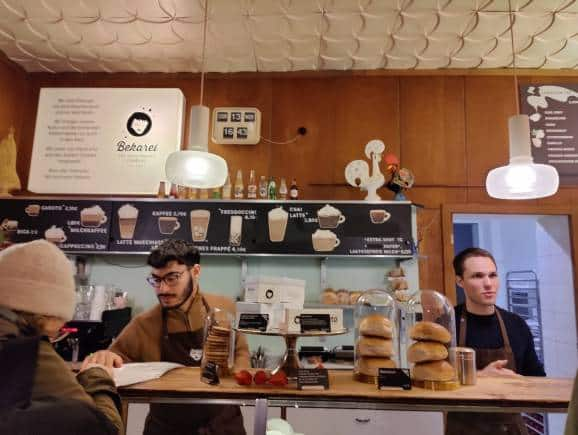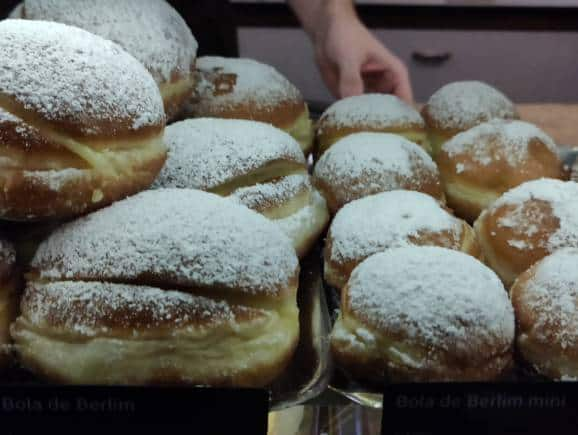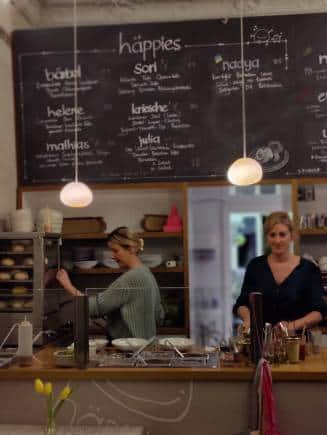From moneycontrol.com
Burgers without meat, cakes without eggs and ice cream without regular milk are all becoming increasingly common in Berlin. There are also animal-free butchers, selling meat-free versions of smoked bacon strips and mince

Roughly 80,000 people in Berlin are vegan. Vegan restaurants have cropped up everywhere, and most other restaurants stock vegan options, too. (Photo by Kalpana Sunder)
Currywurst started as a cheap street food when the devastated city was being rebuilt after World War II. An enterprising person poured some sauce with curry powder taken from British soldiers over pieces of pork sausage, and the Currywurst was born!
Ketwurst, on the other hand, is something that was invented by East Berliners - a sausage slathered with ketchup and stuffed into a hollowed-out roll.
What I bite into is a vegan version of the real deal. “It’s cheap and a on-the-go food, with a lot of history behind it,” says Violeta, my local guide.
I am taking a food tour with a local tour company called Fork and Walk, in the gentrified neighbourhood of Prenzlauer Berg, formerly East Berlin, and today, a hub of vegan and vegetarian restaurants and cafes.
Violeta talks about how Berlin has exploded in the last decade as the vegan capital of Europe, with vegan restaurants, vegan supermarkets and even a vegan butchery.
American food magazine Saveur awarded Berlin in 2015, for being the only city in the western world in which vegetarian cuisine has achieved “complete culinary parity” with a carnivorous diet. “It’s not just about eating vegetarian, it’s also about a comprehensive lifestyle which is sustainable, from biking and taking public transport to wearing vintage clothes, not wearing leather shoes, recycling and doing yoga and Pilates, by people who are generally in the age group of 20-40,” says Violeta.
 (Photo by Kalpana Sunder)
(Photo by Kalpana Sunder)
Out of a population of 3 million, an estimated 80,000 are vegans in Berlin, and the city today boasts an impressive number of vegan restaurants- more than 80 - besides almost every restaurant offering vegan and vegetarian alternatives.
Burgers without meat, cakes without eggs and ice cream without regular milk are all becoming increasingly common. There are also animal-free butchers, selling meat-free versions of typical meat items like smoked bacon strips and raw mince along with seitan - a food based on wheat proteins.
Vertical farming, community gardens and market halls, all make fresh produce available. Even the Bäkereien (bakeries)–have a number of chains that offer vegan pretzels, pretzel sticks, German-style rolls, croissants and other sweet treats. Berlin also has fine-dining vegetarian restaurants like Cookies cream which has a Michelin star and specializes in seasonal and regional produce.
“It’s all because people are asking more questions now about where the food on their plate comes from,” says Violeta.
We drop into Veganz, Europe’s first vegan supermarket founded in Berlin in 2011, where the motto is “we love life". It sells everything from meat and fish alternatives to cheese alternatives, and plant proteins - even the packaging is compostable here and has inner films made of recycled plastic and cardboard slipcases.
We continue walking through the streets lined with Wilhelmine style apartment houses built in the late 1800s with high ceilings and stucco work, with over 300 protected buildings, many of them with tiny cafes or organic shops located in the ground floors. Shops with local brands, organic food, vintage clothesline the streets.
“After the Wall came down in 1989, this area found itself in the middle of Berlin, with a wealth of old buildings and the then Mayor had an idea to re-energize the place by selling clusters of buildings to real estate builders. Now it’s a hipster place for young families to live, with playgrounds, yoga studios and local shops.
 Bekarei in Berlin (Photo by Kalpana Sunder)
Bekarei in Berlin (Photo by Kalpana Sunder)
We stop at Bekarei, a small bakery that combines East German chic with Portuguese pastei de nata - custard tarts - and Greek pastries, all with their vegan versions, too, with old style retro décor from the times of the GDR (German Democratic Republic) - hanging lamps and plastic chairs, to geometric ceiling art.
Owned by Portuguese Paula Goubeia and Greek Georeg Andradis, who took over an existing coffee shop, they offer flaky Portuguese tarts with vanilla crème, lemon meringue tarts and rustic breads, baked fresh every day. I bite into the delicious vegan custard tarts, with a cup of coffee.
A short hop away is our next stop, a popular place frequented by locals called Brammibal’s – famous for its vegan doughnuts that have no holes in the centre. Instead, they are stuffed with vanilla custard or plum jam.
 Doughnuts without a hole (Photo by Kalpana Sunder)
Doughnuts without a hole (Photo by Kalpana Sunder)
The bakery is sustainable, and donates leftovers to homeless shelters and uses waste to make biogas. “These are actually variations of the typical local doughnuts called Berliners which have no hole in the centre and are usually made from deep-fried yeast dough and filled with jam,” explains Violeta.
It’s a small minimalistic place with wooden tables and chairs and pink neon lights. In the glass shelves are stacked different flavours of doughnuts, from choco pumpkin spice to salted caramel. One bite into my doughnut along with ethically sourced coffee, and I am in love with the place.
Violeta talks to me about how seriously Berlin takes its recycling, showing me the different coloured garbage bins for segregation on street sides, as well as separate segregation for bottles of different colours.
 Happies (Photo by Kalpana Sunder)
Happies (Photo by Kalpana Sunder)
Our next stop is a tiny, cosy restaurant with hanging lights and blackboards displaying the day’s menu. It's run by Uli Marschner, who has named every dish after a person that she has been associated with.
The partly crowdfunded café is called Happies. It serves only vegetarian food and does exude a happy vibe. I settle for the Indian-inspired lentil-loaded “Krische” served with Chutney, Yogurt and Papadam. I am floored by the presentation – Asian-style steamed bao buns filled with lentils. Violeta explains that it is Uli’s take on Knodel German dumplings along with some Indian inspiration.
Violeta talks about the various influences which have made Berlin a vegan capital. She says that because of the hardships and wars faced by the Germans in past times, meat had been associated with being rich, and aspirational. But now the people have gone back to what is healthy. Also, Berlin is a melting pot of various cultures and nationalities- it has the largest Turkish population outside Turkey, who were among the first to open their donor kebab and shawarma shops, and then the Lebanese and the Syrians followed in the '70s.
 (Photo by Kalpana Sunder)
(Photo by Kalpana Sunder)
“In countries like Lebanon and Syria, there has been always a tradition of vegetarian food for those fasting in the Lent period and therefore these eateries always offered at least a couple of vegetarian options.”
We stop by at Zweistrom, a Middle-Eastern restaurant named after the Land of two rivers by the Iraqi owner, that serves a wholesome mezze platter for approximately 10 Euros with haloumi cheese, couscous, Tabouleh, Baba Ghanoush, and swirls of creamy hummus with a delicious roasted vegetable paste. It’s a filling dinner and entirely vegan.
Our last stop is a fitting end to our food odyssey. It’s a crowded bakery called Zeit Fur Brot, with racks filled with baked goodies and famous for its cinnamon buns and rolls. Young people sit on wooden steps and chairs, with coffee and buns. Violeta shows me the number of vegan options they have, from sandwiches and quick meals like rice and lentils to baked rolls and buns. I sit down to rest my weary legs, and munch on a cinnamon bun, musing on how much a country can change in a decade - from meat loving to vegan friendly!
Kalpana Sunder is an independent travel writer. She is on Twitter @KalpanaSunder
No comments:
Post a Comment